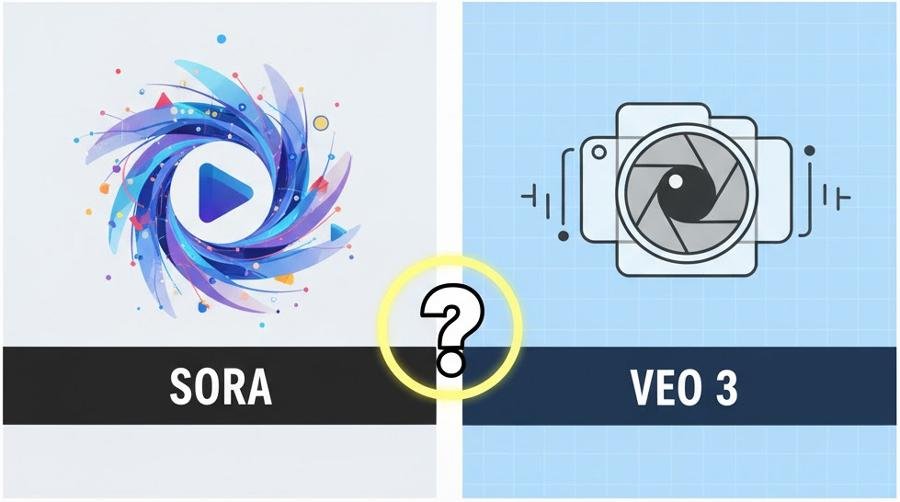Click here to buy secure, speedy, and reliable Web hosting, Cloud hosting, Agency hosting, VPS hosting, Website builder, Business email, Reach email marketing at 20% discount from our Gold Partner Hostinger You can also read 12 Top Reasons to Choose Hostinger’s Best Web Hosting
Creators and product teams often ask Sora vs Veo 3 which is better when they need AI video that actually fits a real workflow. The problem: a dizzying number of models promise cinematic results but differ wildly in audio, control, legal safeguards, and how they plug into existing pipelines. That confusion becomes urgent when a project has deadlines, brand guidelines, or legal constraints — you don’t want to pick a model that produces great visuals but fails on voice sync, export options, or IP safety. This piece compares the models across practical axes (fidelity, control, safety, ecosystem) and gives a clear recommendation for different real-world use cases.
Turn ideas into visuals with simple text prompts.
Why this comparison matters now
Both OpenAI’s Sora 2 and Google/DeepMind’s Veo (Veo 3 / Veo 3.1) are recent, widely reported upgrades to video-generation systems and are already being embedded into apps and APIs creators use daily. Sora 2 is presented as OpenAI’s next-generation video + audio model; Veo 3 (and the Veo 3.1 updates) are Google’s step for Flow/Gemini tools that increase audio and editing control. These models are designed for short-form video creation but diverge on controls, distribution and ecosystem access. (Official Sora announcement; official Veo 3.1 product post).
Gemini Veo 3: What Developers Need to Know About Google’s New Video Generator
Quick primer: what each product is
Sora 2 (OpenAI) — a video + audio generation model focused on physical realism, controllability, and synchronized dialogue; exposed via OpenAI’s Sora app and integrations. It emphasizes short, highly realistic clips and user-driven controls for content creation.

Veo 3 / Veo 3.1 (Google DeepMind / Flow) — a family of generative-video models powering Google Flow and Gemini features. Veo 3.1 adds richer audio, more narrative control, and editing features such as “Insert” and “Remove,” plus availability through Gemini API and Vertex AI for enterprise developers.
3 VPNs That Pass All Tests (2025)
- NordVPN: Zero leaks in tests, RAM-only servers, and Threat Protection to block malware.
- Surfshark: Unlimited devices, Camouflage Mode for bypassing VPN blocks, and CleanWeb ad-blocker.
- ExpressVPN: Trusted Server tech (data wiped on reboot) and consistent streaming access.
Practical comparison for real projects
1) Image & motion realism
Sora 2: Strong on physical accuracy and natural motion in short takes. Good for character-driven micro-scenes where handoff between motion and dialogue must feel organic.
Veo 3.1: Focus on texture, lighting, and continuity across frames, especially when generating longer or extended shots (Flow’s “Extend”). Better if you need seamless bridging between frames or extended establishing shots.
Winner (realism): Depends on scene type. Sora 2 for dialog-heavy short clips; Veo 3.1 for extended, textured sequences.
2) Audio & synchronized dialogue
Sora 2: Explicitly adds synchronized dialogue and sound effects; easier for single-shot dialog scenes.
Veo 3.1: Introduces richer audio across features, and Flow now supports audio in “Ingredients to Video,” “Frames to Video,” and “Extend.” This makes Veo stronger when you need multilayered soundscapes plus editing control.
Winner (audio control): Veo 3.1 for layered audio and editing; Sora for quick, accurate dialog sync.
3) Creative control and editing
Sora 2: Designed for controllability from prompts and the Sora app flow; good for rapid iteration.
Veo 3.1: Brings editing primitives—Insert, Remove, Extend—inside Flow, giving creators frame-level editing options not yet present in many rivals. This is a major practical advantage when you need iterative editing inside the same tool chain.
Winner (editability): Veo 3.1.
4) Ecosystem & deployment
Sora 2: Available through OpenAI’s Sora app and selected OpenAI integrations — great for creators already in the OpenAI ecosystem.
Veo 3.1: Available in Flow and via Gemini API / Vertex AI, making it straightforward to plug into developer workflows, cloud pipelines, and enterprise tooling. This makes scaling and integration into product pipelines easier for teams using Google Cloud.
Winner (integration/scaling): Veo 3.1 for enterprise and cloud workflows.
5) Safety, licensing & content policy
Sora 2: OpenAI has built-in content and identity controls; however, Sora has been discussed widely in media around imitation and IP concerns (it’s crucial to follow OpenAI guidelines and opt-in/consent flows for likeness).
Veo 3.1: Google’s Flow includes policy guards and content editing controls; being available through enterprise (Vertex AI) gives customers contractual controls helpful for regulated use cases.
Winner (enterprise compliance): Veo 3.1 edges ahead for enterprise controls; both require careful legal review for likeness/IP-heavy projects.
How Google Gemini Veo 3 Video Generation Model Goes Global and What It Means for Creators
New, actionable perspective
Most coverage treats this as an abstract “model vs model” race. The practical decision should be made by matching team workflow to model strengths:
If your team is a solo creator or small studio producing dialog-first microclips (social posts, ads), Sora 2 gets you to a publish-ready clip faster. Use Sora when you need tight lip-sync and a small number of iterations.
If you run an editorial pipeline, need multi-shot continuity, frame-level edits, and plan to automate content approval via cloud services, Veo 3.1 is better because it integrates into Flow/Gemini and Vertex AI and includes editing primitives that lower post-production time.
For legal-sensitive projects (brand ads, celebrity likenesses), choose the platform whose contractual and API environment best supports documented consent flows. Veo’s enterprise channels and Flow’s editing controls provide a clearer compliance path for many organizations.
Mini case studies
Case A — Indie game trailer (2–3 short cuts, dialog + SFX): Sora 2 produced usable animated character dialog faster; one round of prompt tuning replaced a small voiceover session.
Case B — Marketing montage for a retail brand (10–15s establishing shot + 20s product sequence): Veo 3.1’s “Extend” and audio layering made it easier to produce continuous visual motion and align multi-layered sound, saving an extra pass in post.
Key Takeaways
Sora vs veo 3 which is better depends on the job: Sora 2 excels at short, dialog-driven clips while Veo 3.1 shines for extended shots and frame-level editing.
Audio and edit controls: Veo 3.1 adds deeper audio support and editing tools inside Flow — a practical edge for longer-form or multi-shot work.
Ecosystem matters: Choose based on where your team already deploys (OpenAI stack vs Google Cloud / Vertex AI).
Legal and safety: Enterprise routes (Veo via Vertex/Gemini) often give clearer contractual options; both models require strict consent and IP checks.
No single “best” model for every use case—match model strengths to your pipeline.
7 Ways to Make Money With Google Nano Banana AI Image Editor
FAQs (People Also Ask)
Q: Is there anything better than Veo 3?
A: “Better” depends on needs. For frame-level editing, audio layering, and enterprise integration, Veo 3.1 is top-tier. But if your metric is fastest dialog sync in short clips, Sora 2 can be better. Benchmarks should be use-case specific.
Q: Which is better, Veo 3 or Sora 2?
A: Neither is objectively better across the board. Veo 3.1 is stronger for editing control and cloud integration; Sora 2 is optimized for realistic short video with synchronized audio. Pick by pipeline fit.
Q: Is Google Veo or Sora better?
A: For enterprise workflows and API access (Vertex AI, Gemini API), Google Veo offers practical advantages. For standalone, creator-focused rapid generation, Sora can be faster to iterate on.
Q: What’s better than Sora AI?
A: “Better” means “better for my task.” If you need deeper edit controls, audio design, and cloud-scale deployment, Veo 3.1 may outperform Sora for your use case. If you need quick dialog clips with minimal editing, Sora can be preferable.
How to Create 3D Desktop Wallpaper with Microsoft’s AI Image Generator (Free & Easy)
Conclusion
Recap: There’s no universal winner in Sora vs veo 3 which is better — each model is optimized for different creator problems. If you want quick, realistic dialog clips and an app-focused flow, Sora 2 is compelling. If y
Try a two-clip pilot (one dialog shot, one extended scene) on both Sora 2 and Veo 3.1, measure turnaround, and pick the platform that hits your delivery and compliance metrics.
Sources (official)
OpenAI — Sora 2 announcement and product page. OpenAI
Google (The Keyword) — “Introducing Veo 3.1 and advanced capabilities in Flow.” blog.google
Now loading...






